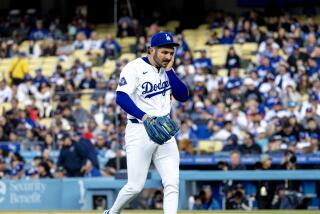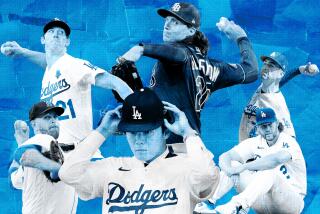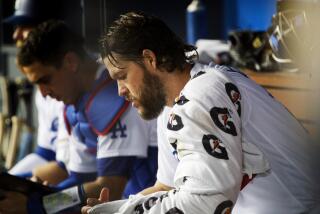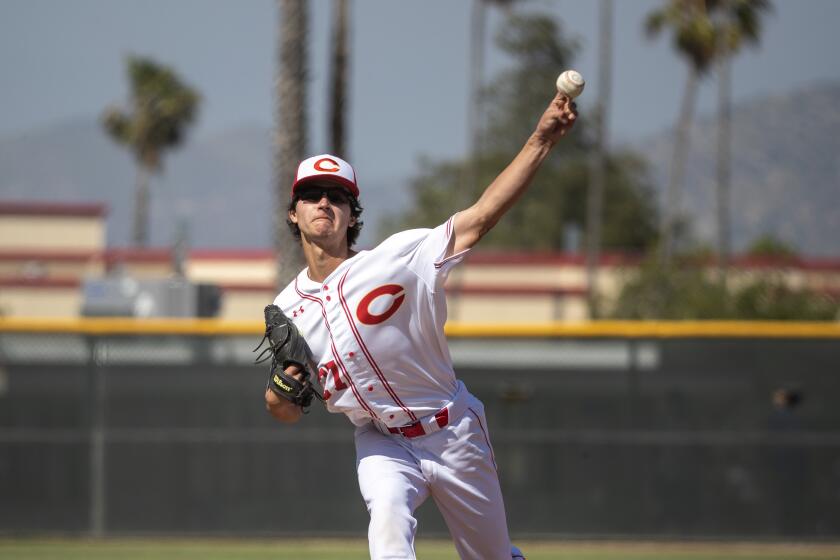Column: Best way for Dodgers to win the World Series is by adding a pitcher
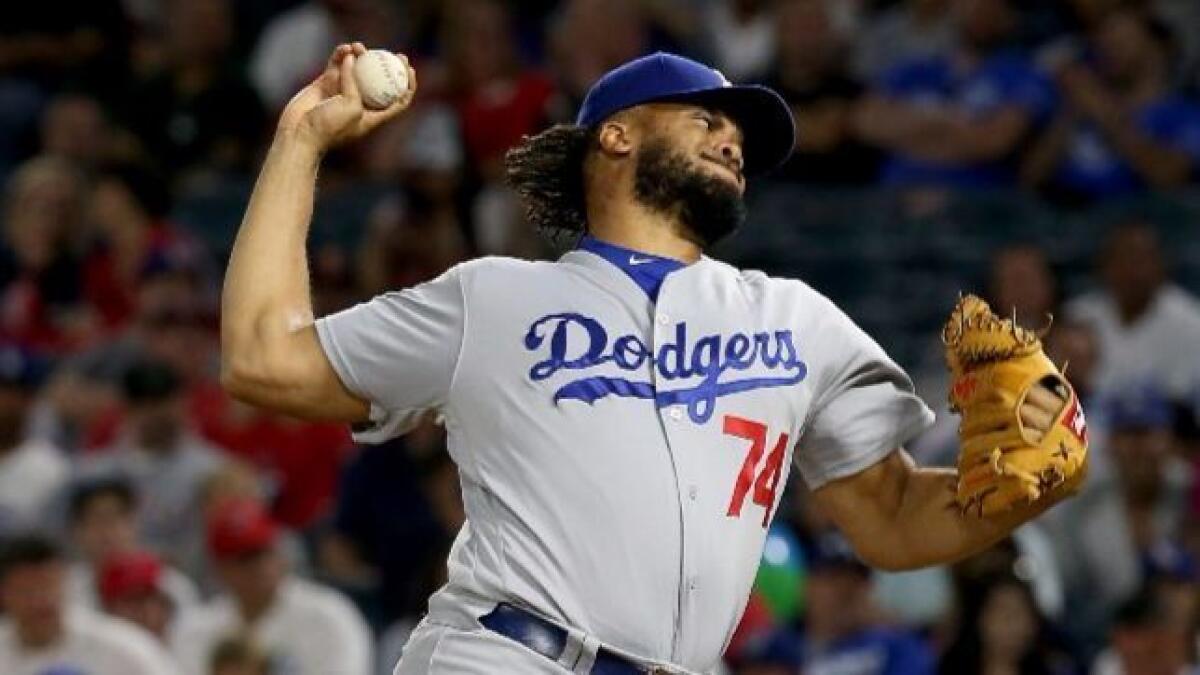
There is no great mystery about the most effective way to win a World Series. The Dodgers demonstrated how in 1963, when they swept the New York Yankees.
The Dodgers got 108 outs in that World Series. Their starting pitchers got 106 of them.
Sandy Koufax pitched two complete games. Don Drysdale pitched one. Johnny Podres, that slacker, came within two outs of a complete game.
Baseball has changed radically over the last half a century, and so have the means to that championship end.
Koufax threw two complete games within five days. No National League team has more than two complete games this season.
The factors are many and familiar: pitch counts that restrict starting pitchers; the emphasis on batters taking pitches and drawing a walk; the rise of the closer, and then the setup man, and then the left-handed specialist; the data that discourage a team from letting a starter face a lineup three times and encourage the use of better relievers earlier in the game.
There are various means to that championship end these days. This is the backdrop for the debate within the Dodgers front office — eight days before the trade deadline, and 29 years since the last parade.
The debate over whether Alex Wood is a No. 2 starter in a World Series rotation misses the point. So does the debate over whether the Dodgers need a better No. 4 starter than Brandon McCarthy.
The debate really is about how the Dodgers can most effectively get the 27 outs they need to win each October game. Are they better off with a starter who can pitch six or seven innings maybe once in a series, or a reliever who can pitch six or seven innings over three or four games?
Whatever answer the front office determines will influence its strategy at the deadline. The Dodgers are interested in Yu Darvish and in Zach Britton.
The asking price for each will factor heavily into this answer, of course, but would the Dodgers be better off sacrificing their precious prospects for a starter like Darvish to pitch behind Clayton Kershaw or a reliever like Britton to pitch ahead of Kenley Jansen?
Remember, the Dodgers had a trade in place for Aroldis Chapman to pitch in front of Jansen last season, then backed away after learning of the domestic-violence incident for which Chapman ultimately was suspended 30 games.
This is the crucial point: Wood and Rich Hill look good now, but the Dodgers have handled each with extreme caution. Wood has not thrown more than 100 pitches in a game this season. Hill has done it once. If the Dodgers won’t let them pitch deep into games now, they certainly can’t expect them to deliver seven innings in October, right?
“That’s fair,” manager Dave Roberts said.
Let’s say the Dodgers get seven innings from Kershaw in his starts, five from Wood, five from Hill. That would leave 30 outs to cover over a three-game span. And, even if Jansen could get six outs in each of those games, that would leave 18 outs.
That is not necessarily a recipe for doom. To the contrary: it is the direction in which the sport appears to be trending.
In the 36 World Series starts over the last three years, the starting pitcher lasted more than six innings only four times — Madison Bumgarner and Johnny Cueto went nine innings, Matt Harvey eight, Yordano Ventura seven. In those 36 starts, the starting pitcher went fewer than five innings 14 times.
In 2002, the last time a Southern California team got to the World Series, the Angels won in seven games. The number of games in which the Angels starter lasted six innings: zero. But Francisco Rodriguez got 26 outs over four games and Brendan Donnelly got 23 outs over five games, in support of closer Troy Percival.
“I don’t think there’s any magic formula to get you to a World Series,” said Mike Scioscia, the Angels manager then and now.
“If you have the Randy Johnson and the [Curt] Schilling, the [Max] Scherzer and the [Stephen] Strasburg, the guys who pitch deep into games, great. If you don’t, you’ve got to find a way to get the game on your terms. It could be the 5 1/3-inning start, with the guys that hold the lead or keep the game where you want it to be. I think it’s just how you piece it together.
“If you’ve got guy that’s going to pitch 21, 22, 23 outs, he’s his own middle man, his own setup guy, and then you have your bullpen after that. If you don’t, you better find a way to do it.”
The guy that built the team with Scherzer and Strasburg, the team the Dodgers might need to beat to get to the World Series, is counting on his aces.
“I’m from the old school,” Washington Nationals general manager Mike Rizzo said. “When you have starting pitching, anything is possible. And, when you don’t have starting pitching, nothing is possible. We built our organization on starting pitching. We rely heavily on it. Each one of our starters gives us a chance to win every day. That’s what we’ve tried to build. That’s what we have this year.
“I think that’s the way a contender has to be built.”
Scherzer and Kershaw are tied for the league lead in innings pitched, with Gio Gonzalez of the Nationals ranking fifth, and Strasburg 11th. No Dodgers pitcher besides Kershaw ranks in the top 40.
The Nationals shored up their faulty bullpen last week, acquiring Sean Doolittle and Ryan Madson. But even then, Rizzo said, he sees no reason why his big three starters cannot pitch into the seventh inning, deep into October.
“We’re hoping for that, and we’re expecting that,” Rizzo said. “It’s been their track record. We’re going to rely on them to take us to the promised land, if that’s at all possible.”
Andrew Miller of the Cleveland Indians got 23 outs over four games in the last World Series, fewer outs than Rodriguez in four games 15 years ago, yet still somehow was heralded as a revolution. As Roberts pointed out, the Indians probably would not have worked Miller quite so hard had they not lost two of their top three starters (Carlos Carrasco and Danny Salazar) to injury in September.
“When you don’t have those guys, and you’ve got off days, and you can deploy relievers for matchups, I think that is kind of the best alternative,” Roberts said.
“If you look at Clayton and those top-tier guys, and they are few and far between, I think it’s more driven by your particular roster.”
Roberts said the Dodgers are fortunate enough not to have a glaring weakness. If there is one priority he would like to see the front office address, it would be the left-handed reliever to face, say, Bryce Harper and Daniel Murphy of the Nationals, in the innings between the starter and Jansen.
“That wipeout lefty is something that does make sense,” Roberts said, “especially looking at potentially who you’re going to face in the postseason.”
And if the front office tells you it can acquire a seven-inning starter or a multi-inning reliever, but not both?
“I don’t have a preference,” Roberts said. “I really don’t.”
Kershaw has pitched in 18 postseason games, none of them in the World Series. He said the Dodgers’ depth affords the front office the chance to build the pitching staff from the front or the back, without worrying that the other end would be too weak to win.
“I think we’re in a good spot as a team,” Kershaw said.
The Dodgers’ chances to win the World Series might be best served by adding another starter, or they might be best served by adding another reliever, but the only way to find out for sure is to get to the World Series.
“I hope we find out,” Kershaw said.
Follow Bill Shaikin on Twitter @BillShaikin
More to Read
Get our high school sports newsletter
Prep Rally is devoted to the SoCal high school sports experience, bringing you scores, stories and a behind-the-scenes look at what makes prep sports so popular.
You may occasionally receive promotional content from the Los Angeles Times.

